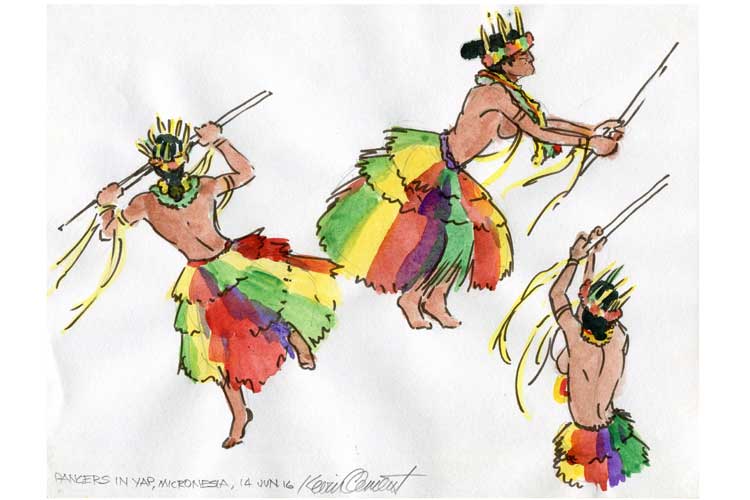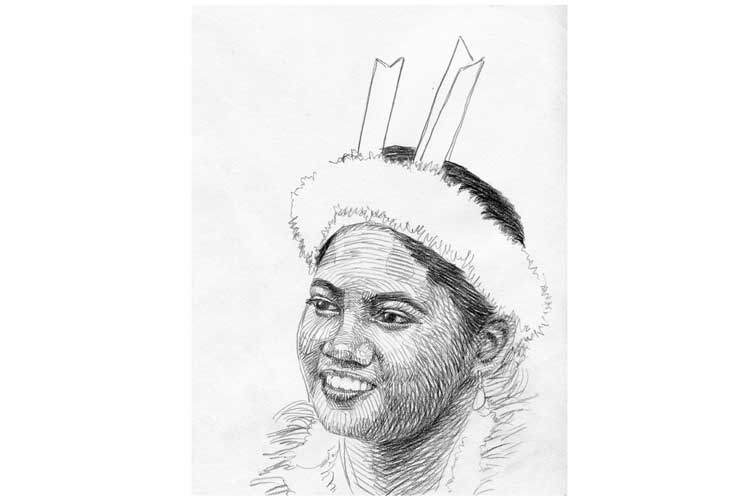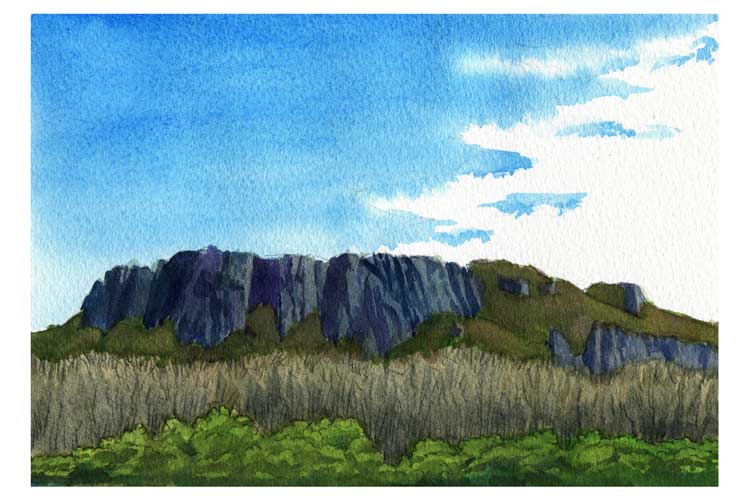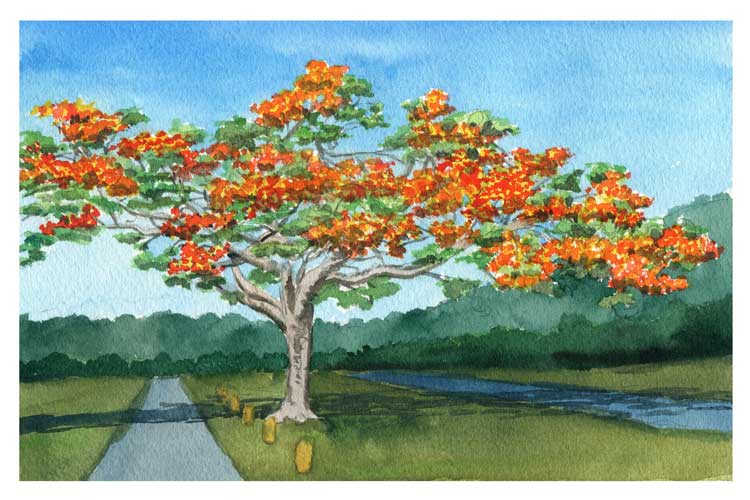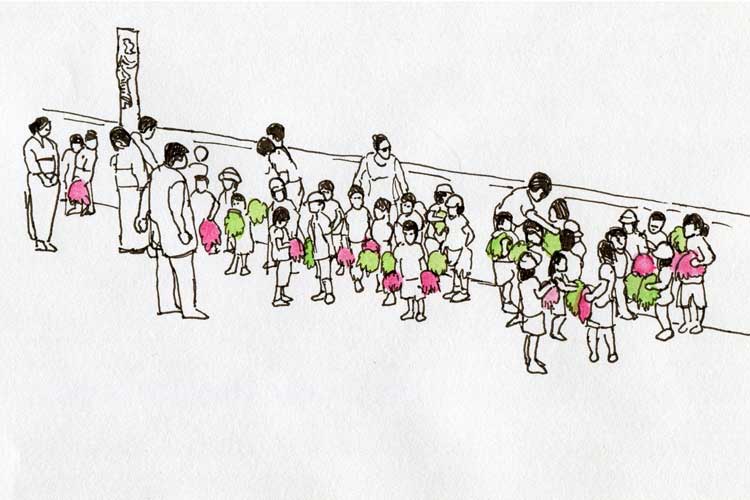An Expedition Artist’s Eye
Posted by Kevin Clement
in Asia & Pacific, Ocean Crossings and Of Interest
Artist and expedition leader, Kevin Clement, recently traveled from Palau to Japan as part of our South Pacific small ship cruise to the Marianas Islands. Here, he shares not only his art but the inspiration behind each piece.
Our expeditions take us to some of the most beautiful places on earth. Small wonder, then, that so many of our travelers carry cameras—they want to record their experiences, to be able to relive them later, and perhaps to create works of beauty. Me, I carry a sketchbook.
I love to draw…and who could help but be inspired by places like the remote islands of Palau, Yap, the Marianas, the Ogasarawas, and the Izos? They are visually stunning places, ranging from tropical paradises to misty primeval forests. On the voyage we’ve just completed, we sailed through all these archipelagos, along the edge of the Pacific Ring of Fire, as we tracked from south to north across many lines of latitude.
So inspiration I had in abundance…time to sit and draw, not so much. It’s always that way when I’m working as an expedition team member on a trip, of course. But I have learned in this job to be fast with my pencils and paints. Here are some of the results:
DANCERS, YAP
We had a really delightful tour of the island of Yap, featuring ruined Japanese zeros, pitcher plants, a men’s house, and the famous stone money. But the finale unfolded as we arrived back in Colonia, the main town.
An amazingly proficient and energetic dance troupe took the stage. The “stage”, by the way, was an open grassy plaza outside the cultural center. I don’t know often these dancers practice or how many opportunities they get to perform, but damn, they were good. Their traditional costumes were resplendent with color; their bodies glistened; their dance was clearly warlike; and their movements, as they swung their fighting sticks, beautiful and martial at once. I started slapping lines and blobs of color down on the paper.
GIRL IN COLONIA, YAP
After the performance, many of us lingered on the dancing ground, coming down from the high of watching the show. One of the dancers, a young woman, approached me. Smiling, she offered me the flower lei she had worn as a headband. I bowed my head and she put it over my hat. She was beautiful.
My eyes followed her as she returned to her troupe and sat down to chat with her friends. I pulled my sketchbook back out.
SUICIDE CLIFFS
Saipan to me was a strange and dichotomous place. On the one hand, it is a gorgeous tropical island, bathed in sunshine. On the other, it has a dark history and a grim story to tell. Near the end of WWII, as American troops took the island, thousands of Japanese civilians killed themselves by leaping from high cliffs, which now bear the names Banzai and Suicide.
In a way, I feel that this painting is a failure. As I stood atop the Banzai Cliffs, looking toward Suicide Cliff, I wanted the image to reflect some of the horror we’d all just been learning about. I wanted the precipice to at least look dark and ominous. But looking at the picture now, I don’t see much of that. I think the sheer scenic beauty of the scene subverted my intentions.
FLAME TREE, SAIPAN
Half a world away from the United States, on the opposite side of the widest ocean on earth, tropically exotic in appearance, Saipan is nevertheless a startlingly American place. I knew this going in, but it was still a bit of a shock to see the arrowhead emblem of the National Park Service adorning the entrance to a large modern building, and the staff inside wearing the familiar gray and green Ranger uniforms.
This was the American Memorial Visitor Center, built in honor of those who had given their lives in the bloody battles for this remote island. It housed an excellent little museum and a theatre. In spite of the fact that we had arrived five minutes before closing time, the Rangers graciously admitted us and put on a well-produced historical film for us.
Everyone enjoyed this movie. But I missed it. I couldn’t quite bring myself to go into a dark, enclosed theatre, even for 25 minutes, when it was so glorious outside and there was so much to look at. For one thing, the island was dotted with flame trees (Delonix regia, also known as “flamboyants” and “poincianas”), and all seemed to be in bloom. Each was a blaze of vibrant color in what was otherwise at times a bleak and forbidding landscape.
Or to quote the great Somerset Maugham, arriving in a South Pacific port, “…the flamboyants, scarlet against the blue sky, flaunt their color like a cry of passion. They are sensual with an unashamed violence that leaves you breathless.”
CHICHIJIMA KIDS
Our first stop in Japan, the remote island of Chichijima, was very…Japanese. The port’s infrastructure was complete, the facilities were tidy and well-maintained, the hospitality was warm, the regulations were rigid, and the bureaucracy was dense. And cuteness was present. Our cultural expert had just been telling us about the Japanese predilection for cuteness, and this too was on display.
As we sat on the ship at the ample dock, waiting for the immigration officials to clear us in (a lengthy process), we became aware that a greeting committee had formed. To welcome us, the town fathers had brought what appeared to be every primary school student in town to make a presentation, and had equipped them with green or pink pom-poms. They were all very excited—they don’t see many visitors like us. As they waited for us and we waited for clearance, I stood at the rail of the ship with my sketchbook.
As always, I wish I’d had more time for sketching during the voyage. But attenuated though it may be, the trail of drawings creates for me a kind of record of my trip. Each one has the power to bring me back to that place and time. I remember my surroundings, how hot the sun was on my face, whether the wind was blowing, the texture of the rock I was sitting on while I worked. So ultimately, the sketches serve their most important purpose—they help me reconnect with a beautiful experience.
Learn more about Kevin and the interesting expeditions he designs and leads at Travelling with Kevin Clement

